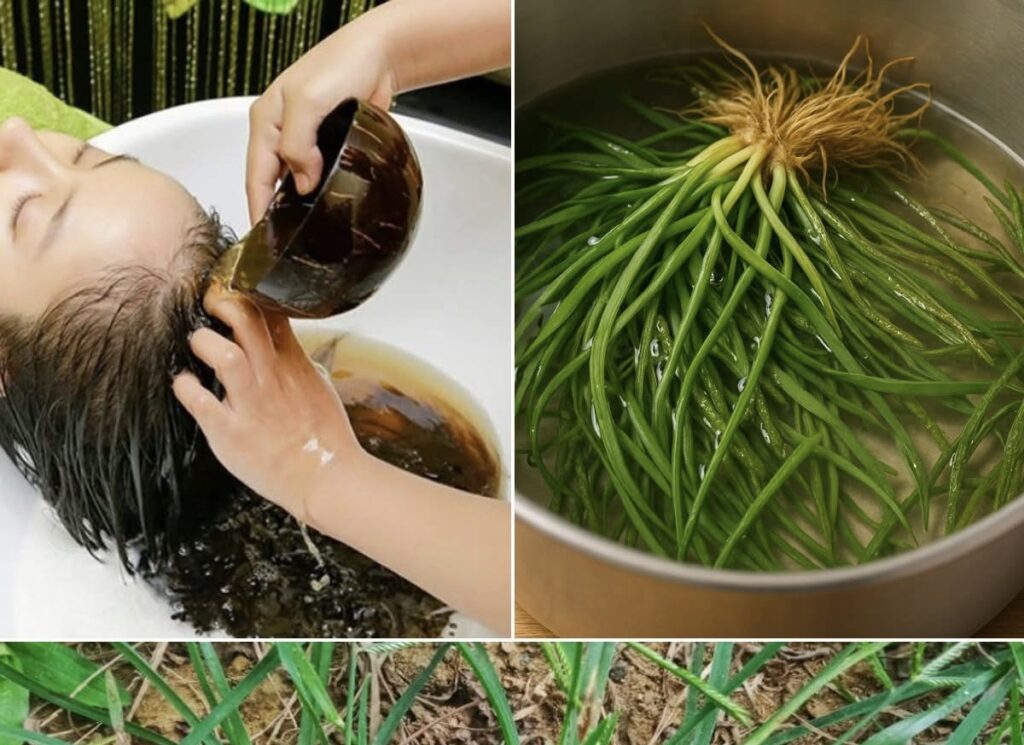
Traditional Herbal Hair Treatment Recipe Using Wild Herbs
Introduction
Hair is often considered the crowning glory of an individual. For centuries, various cultures have used herbal remedies to maintain, nourish, and restore hair. This traditional herbal hair rinse, inspired by the knowledge of ancient Asian and Ayurvedic medicine, uses wild herbs such as wild garlic grass, Eclipta prostrata (Bhringraj), and daylily root to strengthen hair roots, reduce hair fall, and promote natural shine.
Ingredients
- 2 cups fresh wild herb roots (like daylily root or Bhringraj root)
- 5 cups water
- 1 tablespoon black tea (optional for darkening hair)
- 1 tablespoon fenugreek seeds (for scalp nourishment)
- 1 tablespoon amla (Indian gooseberry) powder
- 1 tablespoon coconut oil or sesame oil
- 5–6 fresh neem leaves (for antibacterial properties)
Preparation (Formation)
- Wash the roots thoroughly to remove dirt and soil.
- Boil 5 cups of water in a deep pot.
- Add the herbs, black tea, fenugreek seeds, and neem leaves.
- Let it simmer on low heat for 20–30 minutes.
- Turn off the heat, add the amla powder, and let it steep for another 30 minutes.
- Strain the liquid using a muslin cloth or fine strainer.
- Mix in the coconut or sesame oil once the mixture is lukewarm.
- Store in a glass bottle for up to 1 week in the refrigerator.
How to Use (Method)
- Apply the herbal rinse on clean, damp hair and massage gently into the scalp.
- Leave it on for 20–30 minutes like a hair mask.
- Rinse off with plain water (no shampoo required).
- Use 2–3 times a week for best results.
History
This treatment traces its roots back to ancient Chinese and Ayurvedic practices, where wild herbs and roots were revered for their healing and restorative properties. In rural villages, elders used to handpick herbs from the forest, boil them, and apply the decoction to treat hair loss, dandruff, and greying.
Benefits
- Stimulates hair growth by increasing blood circulation to the scalp.
- Prevents premature greying with regular use.
- Reduces dandruff and itchy scalp due to antifungal properties.
- Strengthens roots and minimizes breakage.
- Adds a natural shine and smoothness to the hair.
Nutrition Profile (Topical)
While not consumed internally, the nutrients beneficial for hair and scalp include:
- Vitamin C (from amla): Antioxidant, stimulates collagen.
- Iron & Magnesium: Support follicle strength.
- Proteins & Lecithin (from fenugreek): Nourish scalp.
- Fatty acids (from coconut/sesame oil): Moisturize and protect.
Lovers of This Recipe
Many herbal beauty enthusiasts and natural remedy lovers embrace this treatment:
- Grandmothers and traditional healers: Swear by its efficacy for hair health.
- Naturalists and herbalists: Prefer it over chemical treatments.
- Beauty influencers: Now popularizing it in holistic haircare routines.
Conclusion
This herbal rinse is more than just a recipe — it’s a time-honored ritual that connects us with nature and ancestral wisdom. With regular use, it doesn’t just nourish your hair but becomes a soothing self-care practice. Whether you’re struggling with hair loss, dullness, or scalp issues, this blend offers a gentle and effective solution.
With Love from Herbal Hair Care Lovers
If you’re passionate about natural beauty and health, this recipe is a treasure. Share it with your family, friends, and fellow herbal lovers. Let the knowledge of generations continue to thrive — one healthy strand at a time.
